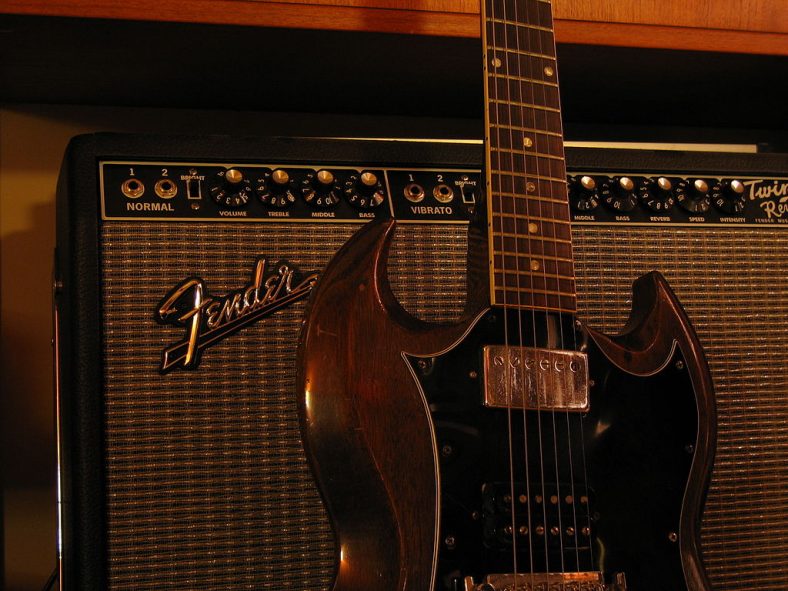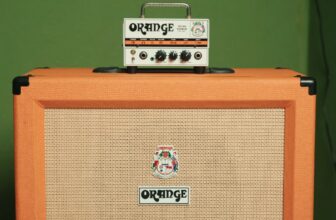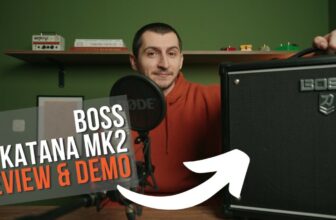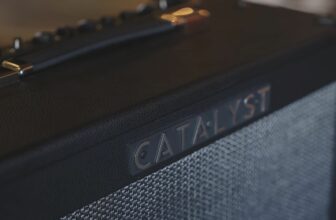Fender Twin Reverb Review from An Experienced Guitar Player (2024)

When we are talking about the most iconic guitar amps of all time, the Twin Reverb is definitely one of the first names that come to mind.
Beloved by so many guitarists around the world, this unit is still a wet dream of so many guitar players, almost 60 years after the initial launch. That’s the reason why the company came up with a reissued version, which does bring a little bit of modern touch but essentially brings the legendary design back.
Contents
No matter what’s your playing style, the Fender Twin Reverb is definitely a must-try guitar amp. It delivers one of the cleanest tones you will ever hear, while the presence of two quintessential vintage effects, Reverb and Vibrato, brings the genuine flavor of the ‘60s back.
Fender Twin Reverb – Price Comparison
Design
In terms of base design characteristics, the reissued version of Fender Twin Reverb isn’t much different compared to the original. Just one look is enough to see that there are no significant visual differences between the two units. More importantly, things aren’t much different on the inside either.
Ten tubes in total are responsible for the super clean tone this amp delivers.
In the preamp section, you will find four 12AX7, while the power amp relies on good-old 6L6 tubes. There are four of them and we can say they are the main reason why the tone remains crystal clean even if you crank the volume all-away up. Of course, we are talking about the legendary Blackface-era circuit, which is responsible for the sound you have heard on thousands of records. The built-in effects are also tube-powered.
When it comes to physical characteristics, the amp measures around 26.5 inches in width, which is no wonder considering that it comes with two excellent 12” Jensen speakers, which offer an impressive dynamic response and really shine in hi-end registers.
Controls
There are more knobs on this amp than you might expect, but things are actually very simple.
This is a two-channel amp and a great thing is that you may count on separate controls. Of course, we are talking about the typical 3-band EQ section and Volume knobs. Additionally, there are controls for effects, one for the Reverb and a couple of knobs for the Tremolo (or Vibrato if you like) effect.
Another great feature of this amp is that there is a small Bright switch for each channel. With this engaged, you may count on even more focus on hi-end frequencies, which have a pretty big impact on the tone clarity. It works great with humbuckers as well.
When it comes to inputs and outputs, you can count on a couple of them at the front. The backside of the amp is rather simple. There are typical Power and Stand By switches, along with an External Speaker out and a Footswitch input. Speaking of the footswitch, you may count on a two-button unit that is included in the price. On the other side, the main drawback of this amp is the lack of an FX loop.
Sound
We’ve finally come to the most interesting part of this guitar amp.
The secret of Twin Reverb’s unmistakable tone is in the legendary Blackface-era circuit.
This design has been introduced in 1963. It was used for a number of Fender amps, including the Twin Reverb model produced until 1967. As we’ve already mentioned, the reissued version comes with the same circuit, as well as with four 6L6 power tubes.
Obviously, we are talking about a class AB amp, which means that the focus is on clean tones. This is where Fender amps really shine and Twin Reverb is no exception. The 6L6 tubes are the reason why this amp remains perfectly clean, even at the highest volume settings. We are talking about a lot of character and those who are familiar with Twin Reverb’s tone will hardly mistake it for another Fender amp. After all, this amp has been the favorite workhorse of so many players and you can hear it on thousands of records.
The amp is good for about 85W. That’s a highly respectable amount of power, so we can say Twin Reverb is capable of pretty much anything. The amp is loud enough for all kinds of events, while the built-in reverb and vibrato make everything even more convenient. Of course, there are a couple of tubes responsible for these two effects and that legendary spring reverb is where this amp really shines.
A couple of 12” Jensen speakers work in perfect symbiosis with the power amp. We already mentioned their excellent dynamic response. The whole amp breathes with an amazing dose of character.
How About Pedal Effects?
Such a recognizable sound isn’t the only tonal quality of this amp.
We are talking about one of the most pedal-friendly guitar amps around.
Even though there is no such thing as an FX loop in this case, and many see this as the amp’s biggest drawback, pedals sound fantastic in a combination of Twin Reverb. We already talked about the amp’s unique character but at the same time, it somehow remains pretty neutral to pedal effects.
You may not be able to order pedals in your signal chain in the way you want, but be sure that all of them will sound really amazing with this amp. Fender Twin Reverb is one of the rare amps on the market that doesn’t affect the tone of pedals. Moreover, it makes them even better.
Finder Twin Amps
The reissued Fender Twin Reverb closely resembles the legendary ’65 model, but that’s just one of the amps that belong to the so-called Twin family. Twin amps have been around for more than seven decades and many of its models are true legends.
The first Fender Twin appeared in 1952 and interestingly, it had “just” 25 Watts of power. This was the first time to see a Fender amp with two speakers, after a series of single-speaker units.
Soon after, the company started with the first revisions. In 1957, we saw a new circuit, called 5E8A. Besides new tonal characteristics, the output was increased as well, up to 40W and 80W. The early ‘60s were particularly interesting, as that’s the time of the Blackface era. It officially started in 1963, with the launch of a new Twin Reverb model. It came with integrated reverb and vibrato, although the latter was essentially a tremolo.
Soon after, Leo Fender sold his company to CBS. Like always, new owners like to change things, so the Blackface era ended already in 1967. That’s way too soon from today’s perspective. The Silverface era was started and it included a completely new external design. Changes were made on the inside as well, and the biggest ones are in terms of power, as the output was increased to 100 and 135 Watts. However, engineers were struggling to get the natural sound that characterized previous versions.
Therefore, lots of modifications have been made during the ‘70s. Finally, the company came with the Twin Reverb II, which had a pretty long production cycle, measured in decades. In 1994, we saw a model called Twin Amp, which comes with the legendary Blackface layout, but without tremolo. On the other side, there were several modern tech goodies, including a Low Power switch, which reduces power from 100 to 25 Watts. This amp was replaced in 2002, with the Pro Tube Twin Amp, which was the first modern amp to come with a full tube tremolo.
Since then, we’ve been seeing reissues of vintage versions only. Of course, there is the ’65 Reissue, as well as the ’68 Custom Twin Reverb, which came with a couple of parts borrowed from the Bassman.
Finally, the last year has brought a model called Tone Master Twin Reverb, which is a digital recreation of the legendary tube amp.
Featured image by Tom Harpel / CC BY





